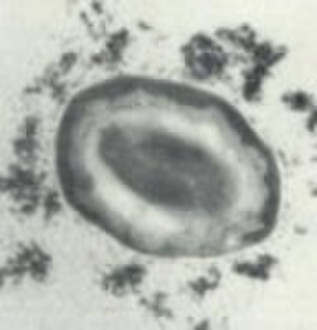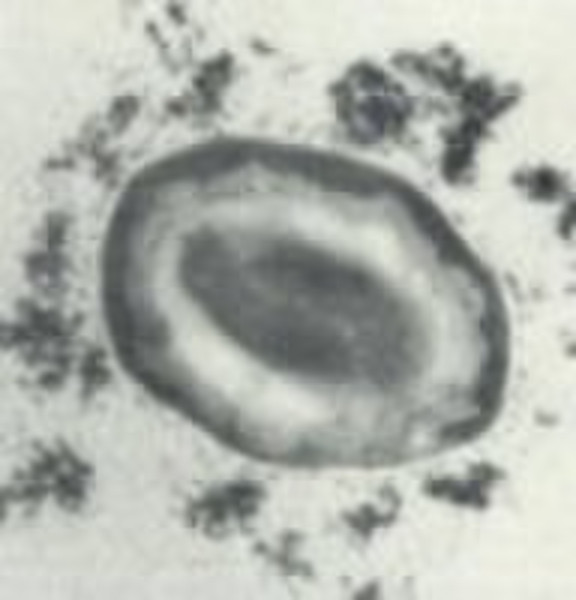Bacillus subtilis

Quincey Cheung
联系人姓名
基本信息
| 分类 | Fungicide |
|---|---|
| 化学文摘社编号. | 12211-28-8 |
| 其他的名字 | Bacillus subtilis (Ehrenberg) Cohn... |
| Einecs编号没了 | 235-390-3 |
| 出生地 | China (Mainland) |
| 纯洁的 | TECH |
| 适用 | in feed |
| 国 | 粉 |
Bacillus subtilis SPECIFICATION General description: Bacillus subtilis cells are rod-shaped,Gram-positive bacteria that are naturally found in soiland vegetation. Bacillus subtilis grow in the mesophilic temperature range. The optimal temperature is 25-35 degrees Celsius (Entrez Genome Project). Stress and starvation are common in this environment, therefore, Bacillus subtilis has evolved a set of strategies that allow survival under these harsh conditions. One strategy, for example, is the formation of stress-resistant endospores. Another strategy is the uptake of external DNA, which allow the bacteria to adapt by recombination. However, these strategies are time-consuming. Bacillus subtilis can also gain protection more quickly against many stress situations such as acidic, alkaline, osmotic, or oxidative conditions, and heat or ethanol. The alternative sigma factor ?B is a global regulator of stress response. Heat, acid, or ethanol and glucose or phosphate starvation are all stimuli that activate B. Cell structure and metabolism: Bacillus subtilis are rod-shaped bacteria that are Gram-positive (Perez 2000). The cell wallis a rigid structure outside the cell. It is composed of peptidoglycan, which is a polymer of sugars and amino acids. The peptidoglycan that is found in bacteria is known as murein.Other constituents that extend from the murein are teichoic acids, lipoteichoic acids, and proteins. The cell wall forms the barrier between the environment and the bacterial cell. It is also responsible for maintaining the shape of the cell and withstanding the cell's high internal turgor pressure (Schaechter 2006). B. subtilis is capable of butanediol fermentation. It does not hydrolyze phospholipids nor casein; it does hydrolyze triglycerides. It produces citrate permease and cytochrome c. Bacillus subtilis is a model organism for studying endospore formation in bacteria. Endospores in Bacillus subtilis bacteria are mostly formed in the tips of protuberances extending downward from liquid surface pellicles (Schaechter 2006). Many strains produce spores with brown pigments. Depletion of carbon, nitrogen, or phosphorous causes the process of sporulation to begin, however, the process needs to start before the entire exhaustion of nutrients (Perez 2000). Otherwise, the spore formation cannot be completed due to the fact that the nutrients are too low for the energy-requiring sporulation process. This allows the cells to avoid being stuck in a vulnerable position. Genome structure: Only one DNA molecule is present in these cells. Bacillus subtilis has one circular chromosome. The total size of all the DNA is 4,214,814 bp (4.2 Mbp) (TIGR CMR). 4,100 genes code for proteins. 53% of the protein-coding genes are only seen once, while 25% of the genome relates to families of genes that have undergone gene duplication .A great portion of the genome corresponds to carbon source applications. 192 of the 4,100 genes are considered indispensable, and an additional 79 are thought to be essential. Most of the essential genes are involved in metabolism. Half of the essential genes are responsible for processing information, one-fifth of them are responsible for cell wall synthesis, cell division and shape, and one-tenth of them were responsible for the energetics of the cell. The essential genes that code for functions that are not known are 4%. Bacillus subtilis bacteria are capable of secreting antibiotics in great numbers to the exterior of the cell. Five signal peptidase genes were found to be important for this secretion function. Many of Bacillus subtilis cells' genes are responsible for antibiotic synthesis. Application to Biotechnology: Bacillus organisms, isolated by soil sprinkle technique, are responsible for producing antibiotics. The most antibiotic activity was seen in Bacillus subtilis MH-4. The most optimal activity occurs at a temperature of 37 degrees Celsius and a basic pH of 8. Glycerol is the optimal carbon source and L-glutamic acid is the optimal source of nitrogen. The antibiotic bacitracin was determined to be affective on Gram-positive bacteria only. Other antibiotics that Bacillus subtilis form are polymyxin, difficidin, subtilin, and mycobacillin. Polymyxin is affective against Gram-negative bacteria, whereas difficidin has a broader spectrum Scope of application: Bacillus subtilis is widely applied in feed so does it in wastewater treatment,biological fertilizer fermentation and production of fermentation bed, BS is a kind of multi-functional microbes. 1,treatment of municipal and industrial sewage;of industrial circulating water;of septic tanks;of husbandry breeding animals' waste,stink;of fecal treatment systems,of garbage,cesspit,cesspot and so on. 2,breeding of livestock, poultry and special animal,aquaculture and pets. Note: 1, can work with low concentration antibiotics, can not work or store with disinfectors,chemicals, pesticides and so on. 2, over-dose is of no harm to animals.Double dosed in first application, or with environmental change, or to sicken animals. 3,once usage i appreciated,if not, sealed storage. [Storage]: sealed storage in a cool and dry place. Avoid light and moistureproof, [Quality garantee period]:Not less than 24 months when intact.
交货条款及包装
端口: Shanghai
付款条款
Documents Against Acceptance
Documents Against Payment
Letter of credit
Telegraphic transfer
-
支付方式
我们接受:









